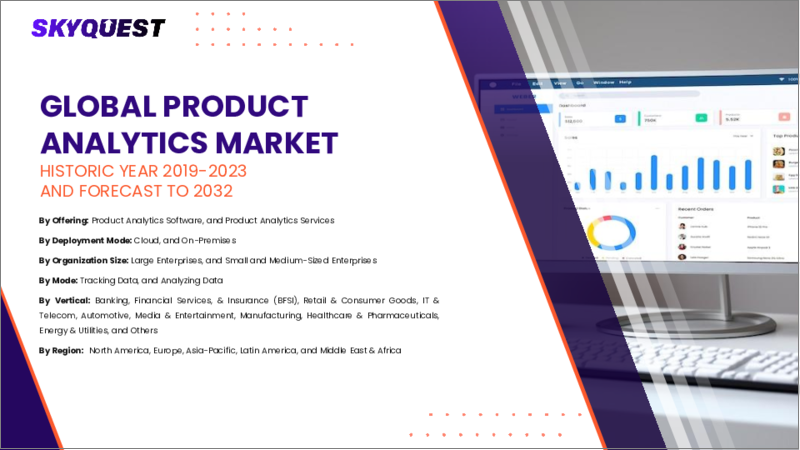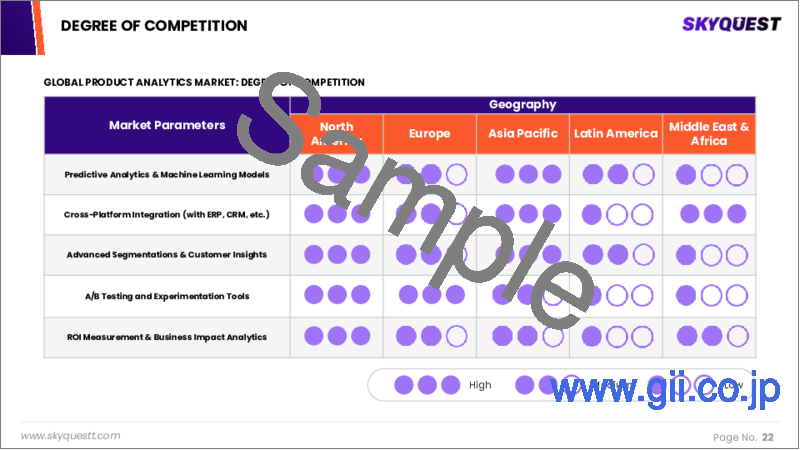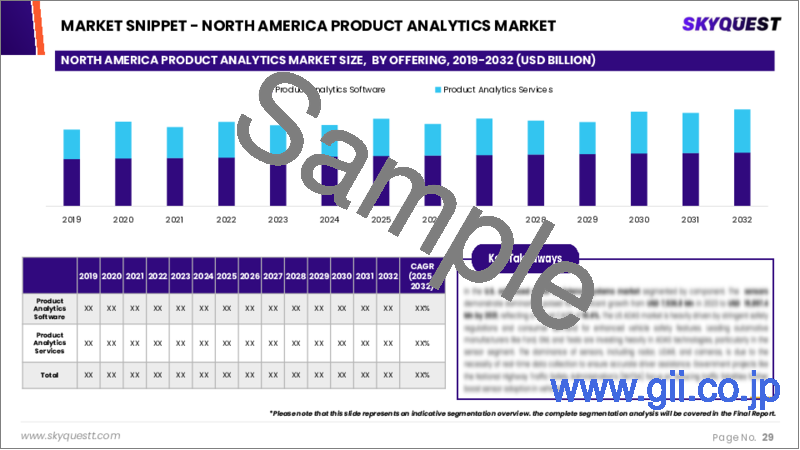|
|
市場調査レポート
商品コード
1610837
プロダクトアナリティクスの市場規模、シェア、成長分析、コンポーネント別、展開別、組織規模別、モード別、地域別 - 産業予測、2024年~2031年Product Analytics Market Size, Share, Growth Analysis, By Component, By Deployment, By Organization size, By Mode, By Region - Industry Forecast 2024-2031 |
||||||
|
|||||||
| プロダクトアナリティクスの市場規模、シェア、成長分析、コンポーネント別、展開別、組織規模別、モード別、地域別 - 産業予測、2024年~2031年 |
|
出版日: 2024年12月09日
発行: SkyQuest
ページ情報: 英文 168 Pages
納期: 3~5営業日
|
全表示
- 概要
- 目次
プロダクトアナリティクスの世界市場規模は2022年に79億7,000万米ドルと評価され、2023年の92億3,000万米ドルから2031年には259億4,000万米ドルに成長し、予測期間(2024-2031年)のCAGRは15.9%で成長する見通しです。
企業が顧客の購買行動を理解することをますます優先するようになるにつれ、プロダクトアナリティクスツールは不可欠なものとなりつつあります。これらのツールはユーザージャーニーを追跡し、ペインポイントを浮き彫りにし、パーソナライズされた体験を提供することで、最終的に顧客満足度と継続率を高める。デジタル時代において、ユーザーエクスペリエンスの向上は最重要課題です。そのため、プロダクトアナリティクスは製品のインタラクションや改善点に関するインサイトを提供します。これにより、ユーザーのエンゲージメントが高まり、コンバージョン率が向上します。さらに、単純なデータ収集では不十分なため、高度な分析ソリューションへの需要が高まっています。ビッグデータ技術を活用したプロダクトアナリティクスプラットフォームは、機械学習とAIを活用して隠れたパターンや動向を発見し、製品開発やマーケティング戦略に役立てます。このようなビッグデータ、AI、機械学習の相乗効果が、プロダクトアナリティクス市場の将来展望を形成しています。
目次
イントロダクション
- 調査の目的
- 調査範囲
- 定義
調査手法
- 情報調達
- 二次データと一次データの方法
- 市場規模予測
- 市場の前提条件と制限
エグゼクティブサマリー
- 世界市場の見通し
- 供給と需要の動向分析
- セグメント別機会分析
市場力学と見通し
- 市場概要
- 市場規模
- 市場力学
- 促進要因と機会
- 抑制要因と課題
- ポーター分析と影響
- 競争企業間の敵対関係
- 代替品の脅威
- 買い手の交渉力
- 新規参入業者の脅威
- 供給企業の交渉力
主な市場の考察
- 重要成功要因
- 競合の程度
- 主な投資機会
- 市場エコシステム
- 市場の魅力指数(2023年)
- PESTEL分析
- マクロ経済指標
- バリューチェーン分析
- 価格分析
- 技術の進歩
- 規制情勢
- ケーススタディ
プロダクトアナリティクス市場規模:コンポーネント別& CAGR(2024-2031)
- ソリューション
- サービス
- プロフェッショナルサービス
- マネージドサービス
プロダクトアナリティクス市場規模:展開別& CAGR(2024-2031)
- クラウド
- オンプレミス
プロダクトアナリティクス市場規模:組織規模別& CAGR(2024-2031)
- 大企業
- 中小企業
プロダクトアナリティクス市場規模:モード別& CAGR(2024-2031)
- 追跡データ
- データの分析
プロダクトアナリティクス市場規模:用途別& CAGR(2024-2031)
- 設計と製造
- セールス&マーケティング
- 消費者エンゲージメント
プロダクトアナリティクス市場規模:地域別& CAGR(2024-2031)
- 北米
- 米国
- カナダ
- 欧州
- 英国
- ドイツ
- スペイン
- フランス
- イタリア
- その他欧州地域
- アジア太平洋地域
- 中国
- インド
- 日本
- 韓国
- その他アジア太平洋地域
- ラテンアメリカ
- ブラジル
- その他ラテンアメリカ地域
- 中東・アフリカ
- GCC諸国
- 南アフリカ
- その他中東・アフリカ
競合情報
- 上位5社の比較
- 主要企業の市場ポジショニング(2023年)
- 主な市場企業が採用した戦略
- 市場の最近の動向
- 企業の市場シェア分析(2023年)
- 主要企業の企業プロファイル
- 会社概要
- 製品ポートフォリオ分析
- セグメント別シェア分析
- 収益の前年比比較(2021-2023)
主要企業プロファイル
- Accenture
- Adobe Inc.
- Google LLC
- International Business Machines Corporation
- LatentView Analytics
- Medallia Inc.(Thoma Bravo)
- Mixpanel
- Oracle
- Salesforce, Inc.
- Veritone, Inc.
- Pendo
- Amplitude
- Gainsight
- Heap
- Mixpanel
- Useriq
- Latentview Analytics
- Countly
- Plytix
- Riskedge Solutions
結論と推奨事項
Global Product Analytics Market size was valued at USD 7.97 Billion in 2022 and is poised to grow from USD 9.23 Billion in 2023 to USD 25.94 Billion by 2031, growing at a CAGR of 15.9% in the forecast period (2024-2031).
As businesses increasingly prioritize understanding customer buying behavior, product analytics tools are becoming indispensable. These tools track user journeys, highlight pain points, and deliver personalized experiences, ultimately boosting customer satisfaction and retention rates. In the digital age, enhancing user experience is paramount; thus, product analytics provides insights into product interaction and areas for improvement. This leads to greater user engagement and higher conversion rates. Moreover, the demand for advanced analytics solutions is on the rise, as simple data collection proves inadequate. Leveraging big data technologies, product analytics platforms harness machine learning and AI to uncover hidden patterns and trends, informing product development and marketing strategies. This synergy of big data, AI, and machine learning is shaping the future of the product analytics market.
Top-down and bottom-up approaches were used to estimate and validate the size of the Global Product Analytics market and to estimate the size of various other dependent submarkets. The research methodology used to estimate the market size includes the following details: The key players in the market were identified through secondary research, and their market shares in the respective regions were determined through primary and secondary research. This entire procedure includes the study of the annual and financial reports of the top market players and extensive interviews for key insights from industry leaders such as CEOs, VPs, directors, and marketing executives. All percentage shares split, and breakdowns were determined using secondary sources and verified through Primary sources. All possible parameters that affect the markets covered in this research study have been accounted for, viewed in extensive detail, verified through primary research, and analyzed to get the final quantitative and qualitative data.
Global Product Analytics Market Segmental Analysis
Global Product Analytics Market is segmented by Component, by Deployment, by Organization size, by Mode, by Application, and by Region. Based on Component, the market is segmented into Solution and Services. Based on Deployment, the market is segmented into Cloud and On-Premises. Based on Organization size, the market is segmented into Large enterprises, Small and Medium-sized enterprises. Based on Mode, the market is segmented into Tracking data, Analyzing data. Based on Application, the market is segmented into Design & Manufacturing, Sales & Marketing, and Consumer Engagement. Based on region, the market is segmented into North America, Europe, Asia Pacific, Latin America and Middle East & and Africa.
Driver of the Global Product Analytics Market
One of the primary drivers of the Global Product Analytics market is the escalating demand for managing customer behavior effectively. As businesses increasingly adopt product recommendation engines that deliver personalized services to users, the need for tools that enhance customer engagement has surged. These engines leverage customer history and behavioral data to provide tailored product suggestions, optimizing marketing strategies and maximizing their potential. By analyzing and understanding consumer interests, organizations can align their offerings with customer preferences, ultimately leading to improved service and satisfaction. Therefore, product analytics becomes essential in deciphering customer behavior and refining marketing efforts accordingly.
Restraints in the Global Product Analytics Market
One of the significant constraints facing the Global Product Analytics market is the increasing concerns surrounding data security and privacy. As artificial intelligence (AI) and machine learning (ML) technologies are increasingly adopted, they also become susceptible to malicious attacks. Cybercriminals are rapidly leveraging AI and ML to devise more sophisticated methods of breaching security, often outpacing the efforts of security professionals. This heightened risk poses a threat to businesses utilizing product analytics, as unauthorized users may exploit vulnerabilities to access sensitive data. Consequently, the fear of data leaks and potential breaches contributes to reluctance among companies to fully embrace these advanced technologies.
Market Trends of the Global Product Analytics Market
The Global Product Analytics market is experiencing a transformative trend fuelled by the integration of artificial intelligence and advanced analytics. As organizations increasingly prioritize data-driven decision-making, product analytics software equipped with AI capabilities enables teams to effectively analyze, visualize, and track customer behaviors and engagement metrics. This enhanced analytical prowess empowers product managers to assess the effectiveness of digital experiences, diagnose issues, and correlate customer actions with long-term value. Consequently, businesses are not only optimizing their product offerings but are also improving customer satisfaction and retention, driving significant growth in the product analytics sector and establishing a new standard for performance.
Table of Contents
Introduction
- Objectives of the Study
- Scope of the Report
- Definitions
Research Methodology
- Information Procurement
- Secondary & Primary Data Methods
- Market Size Estimation
- Market Assumptions & Limitations
Executive Summary
- Global Market Outlook
- Supply & Demand Trend Analysis
- Segmental Opportunity Analysis
Market Dynamics & Outlook
- Market Overview
- Market Size
- Market Dynamics
- Driver & Opportunities
- Restraints & Challenges
- Porters Analysis & Impact
- Competitive rivalry
- Threat of substitute
- Bargaining power of buyers
- Threat of new entrants
- Bargaining power of suppliers
Key Market Insights
- Key Success Factors
- Degree of Competition
- Top Investment Pockets
- Market Ecosystem
- Market Attractiveness Index, 2023
- PESTEL Analysis
- Macro-Economic Indicators
- Value Chain Analysis
- Pricing Analysis
- Technological Advancement
- Regulatory Landscape
- Case Studies
Global Product Analytics Market Size by Component & CAGR (2024-2031)
- Solution
- Services
- Professional services
- Managed services
Global Product Analytics Market Size by Deployment & CAGR (2024-2031)
- Cloud
- On-Premises
Global Product Analytics Market Size by Organization size & CAGR (2024-2031)
- Large enterprises
- Small and Medium-sized enterprises
Global Product Analytics Market Size by Mode & CAGR (2024-2031)
- Tracking Data
- Analyzing Data
Global Product Analytics Market Size by Application & CAGR (2024-2031)
- Design & Manufacturing
- Sales & Marketing
- Consumer Engagement
Global Product Analytics Market Size by Region & CAGR (2024-2031)
- North America, (by Component, by Deployment, by Organization size, by Mode, by Application)
- US
- Canada
- Europe, (by Component, by Deployment, by Organization size, by Mode, by Application)
- UK
- Germany
- Spain
- France
- Italy
- Rest of Europe
- Asia-Pacific, (by Component, by Deployment, by Organization size, by Mode, by Application)
- China
- India
- Japan
- South Korea
- Rest of Asia Pacific
- Latin America, (by Component, by Deployment, by Organization size, by Mode, by Application)
- Brazil
- Rest of Latin America
- Middle East & Africa, (by Component, by Deployment, by Organization size, by Mode, by Application)
- GCC Countries
- South Africa
- Rest of Middle East & Africa
Competitive Intelligence
- Top 5 Player Comparison
- Market Positioning of Key Players, 2023
- Strategies Adopted by Key Market Players
- Recent Developments in the Market
- Company Market Share Analysis, 2023
- Company Profiles of All Key Players
- Company Details
- Product Portfolio Analysis
- Company's Segmental Share Analysis
- Revenue Y-O-Y Comparison (2021-2023)
Key Company Profiles
- Accenture
- Company Overview
- Business Segment Overview
- Financial Updates
- Key Developments
- Adobe Inc.
- Company Overview
- Business Segment Overview
- Financial Updates
- Key Developments
- Google LLC
- Company Overview
- Business Segment Overview
- Financial Updates
- Key Developments
- International Business Machines Corporation
- Company Overview
- Business Segment Overview
- Financial Updates
- Key Developments
- LatentView Analytics
- Company Overview
- Business Segment Overview
- Financial Updates
- Key Developments
- Medallia Inc.(Thoma Bravo)
- Company Overview
- Business Segment Overview
- Financial Updates
- Key Developments
- Mixpanel
- Company Overview
- Business Segment Overview
- Financial Updates
- Key Developments
- Oracle
- Company Overview
- Business Segment Overview
- Financial Updates
- Key Developments
- Salesforce, Inc.
- Company Overview
- Business Segment Overview
- Financial Updates
- Key Developments
- Veritone, Inc.
- Company Overview
- Business Segment Overview
- Financial Updates
- Key Developments
- Pendo
- Company Overview
- Business Segment Overview
- Financial Updates
- Key Developments
- Amplitude
- Company Overview
- Business Segment Overview
- Financial Updates
- Key Developments
- Gainsight
- Company Overview
- Business Segment Overview
- Financial Updates
- Key Developments
- Heap
- Company Overview
- Business Segment Overview
- Financial Updates
- Key Developments
- Mixpanel
- Company Overview
- Business Segment Overview
- Financial Updates
- Key Developments
- Useriq
- Company Overview
- Business Segment Overview
- Financial Updates
- Key Developments
- Latentview Analytics
- Company Overview
- Business Segment Overview
- Financial Updates
- Key Developments
- Countly
- Company Overview
- Business Segment Overview
- Financial Updates
- Key Developments
- Plytix
- Company Overview
- Business Segment Overview
- Financial Updates
- Key Developments
- Riskedge Solutions
- Company Overview
- Business Segment Overview
- Financial Updates
- Key Developments





